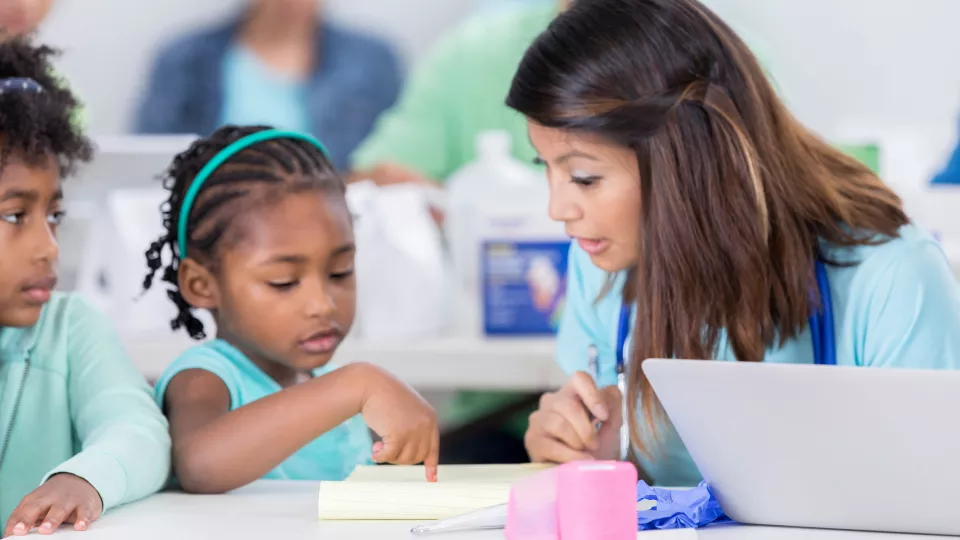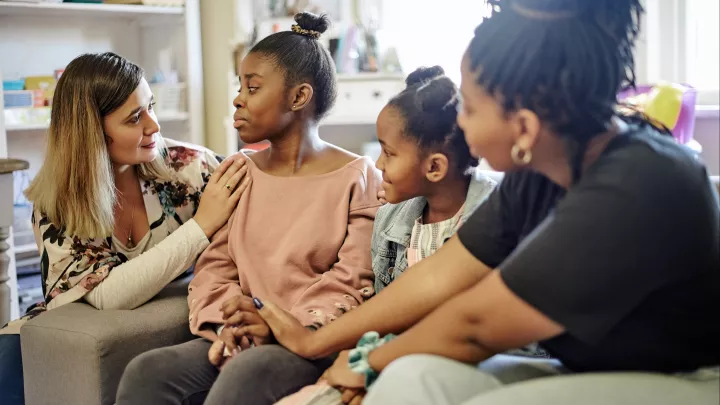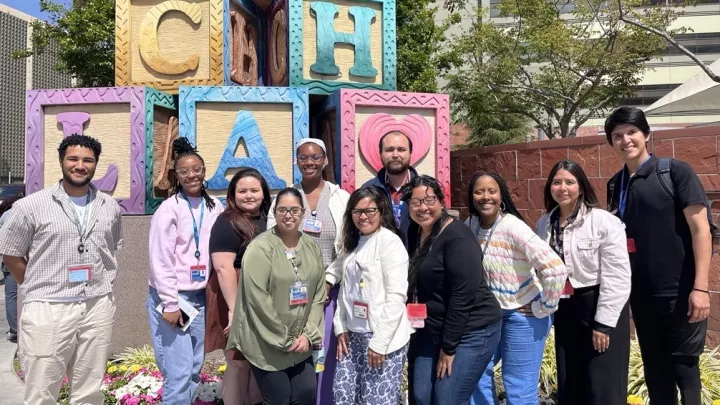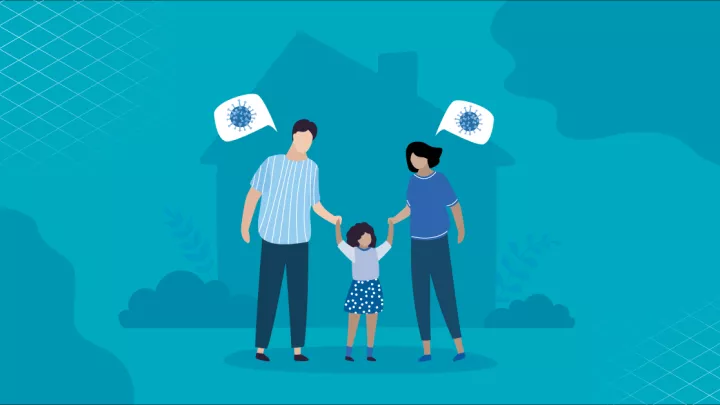
What’s a Social Worker? Here’s the Truth About This Misunderstood Profession
Come to think of it, what is a social worker?
Is it like a community activist, taking on injustice at every turn? Or is it more the opposite, like an evil bureaucrat intent on causing misery? Or is a social worker like what Mr. Rogers called a helper, a person to look to in time of trouble?
In order: no, NOOO, and you’re getting warmer.
It’s no shock if you don’t know; you’re likely in the majority. Many, or even most, people don’t fully know what a social worker does—or worse, believe they know but have a wrong and distorted idea.
“There’s a lot of misinformation about social workers and the role we play,” says Tara Atwood, a Children’s Hospital Los Angeles social worker. “Within the hospital, we really are in a helping role.”
Before Atwood explains what a social worker is, let’s identify what a social worker is objectively not: A social worker is not a cruel civil servant come to confiscate your children. Unfortunately, that’s the characterization pushed by TV writers that has gotten absorbed into the culture—a false portrayal of social workers as the enemy of families rather than their ally.
“When someone hears ‘social worker,’” Atwood says, “they assume I work for the Department of Children and Family Services [DCFS], and there’s a negative association with that—which is the removal of children from homes and families.” When Atwood meets with a family in distress, she often confronts automatic mistrust.
“Sometimes when I go into a room and tell them who I am, I can see an immediate change in their face—panic in their eyes, or worry. You can see the wall immediately go up, like they do not have any intention of talking with me. Like, ‘Why are you here at all? Who called Social Work?’”
But once Atwood engages with them, the family quickly softens up, seeing that she is on their side. It’s then that she can get on with doing her job—the job of a social worker.
“I tell them my role is to check on the family and the patient,” she says, “make sure they’re doing OK, to see if there are any questions or concerns I can help address, and then to get a bit of information from them to make sure they have everything they need when they go home so that they and their child are safe and healthy. As soon as I say that and they hear my tone, they relax and we have a good conversation.”
Four main responsibilities
Atwood began her career in social work in her early 40s. A foster parent, she came to Children’s Hospital Los Angeles often for pediatric care, and her positive interactions with CHLA social workers prompted her interest in becoming one of them. She went back to school, completed a master’s degree in social work and joined CHLA in 2022.
Atwood has worked on several inpatient and outpatient units at CHLA—from 6 East, the trauma inpatient floor, to the Endocrinology unit and the Allergy and Immunology clinic. She has felt the mix of gratification and heartache of social work that rewards her even as it can exhaust her. She can tell you what the job really involves, which she sorts into four principal duties.
Gather information. A social worker’s job one is information gathering, Atwood says, to determine a family’s circumstances and how to best help. She attempts to get a wide view of the family’s situation.
“I ask about resources the family receives,” she says. “I ask about who lives in the home. Is the patient in school? Do they have any developmental or learning delays? We talk about regional center support for the child if they need additional therapies.”
Based on what she discovers, she moves to fill the most critical needs. “So for a kid who has just come to CHLA and is in a foster home, we need to make sure we have all the necessary paperwork on file. If it’s someone who has just crossed the border, then the family needs immediate resources.”
She also screens for abuse and neglect, or any behavior creating a dangerous environment for the child. Although that’s important work, it’s where the false reputation of social work as an agent of punishment has grown. “If there is any violence in the home, we do work with DCFS,” she says.
Find resources. Wherever they are positioned in the hospital, inpatient or outpatient, Atwood says social workers’ purpose and intention are to create better living circumstances for patients and families.
“You ensure that they have all of the things they need to be healthy and to thrive when they are not here in the hospital,” Atwood says.
Making sure a family has safe housing is the first priority, and if they don’t, then she attempts to link them with resources that will allow them to get it. Atwood says another urgent concern is food. With the price of groceries soaring, food insecurity has spiked among poorer families, creating another front for social workers.
“It’s anything from providing immediate meal vouchers so people can eat while they’re here in the hospital to linking them with community resources, like CalFresh and WIC [Women, Infants and Children], to make sure they have food on an ongoing basis.”
Provide emotional support. But what is done for a family that is not at risk, not desperate for money, shelter or food? Atwood says her assessment can reveal that a family is suffering simply from the weight of the health crisis they are enduring with their sick child.
“Many of these parents are just hanging on,” she says. “They're waiting for test results, or they're dealing with chronic medical issues, and they're exhausted from it. Sometimes I will go into a room for a routine assessment and I might ask a question, and immediately tears will form. That's when I know there's more there. Other people in their lives may not have the time or the capacity to just listen, so it builds and builds in them.”
In those instances, she becomes an on-the-spot therapist. “If it's an appropriate time, I simply sit with the family and let them share their experience.”
What they usually most need from Atwood is reassurance. “They’re going through the unknown, and I will tell them they’re doing a really good job. Sometimes they just need to hear that. They need to hear that as parents they've listened to their instincts, they've followed their gut, they've brought their child to the hospital, which was just what they needed, and that they are doing everything they can be doing and that we're here to support them too.”
Screen for mental health issues. Atwood says that assessing kids, especially older ones, for mental health disturbances has become a large part of her work. “Adolescents and teens are really struggling. I don’t know—it could be post-COVID and exacerbated by social media. On a daily basis, I’m talking to multiple adolescents who are really in pain.”
Their time at CHLA is generally short—sometimes just one day—so Atwood says social workers try to put teens in touch with mental health resources before they leave. She says the best she can often offer is simply a listening ear, which is no minor thing.
“Just having a conversation with a child or a teen can open the door for them so they can see that speaking with someone is not scary and might be something that would help them,” Atwood says. “In some cases, we’re talking to someone who has never divulged something, and this is the place they feel safe to do that.”
A side of self-care
Atwood has found that there are consequences to being an all-inclusive support system, and it’s the emotional burden that doesn’t peel right off at the end of a shift.
“The days can feel very heavy sometimes, depending on what we hear,” she says. “We see a lot of families in difficult circumstances, whether they are struggling financially or they’re not able to find the services they need to keep their child healthy and safe outside the hospital. I go home to my family and my children and I think about those families and those children. Yes, I do everything possible that I can within my realm while I’m at work, but there’s a lot I cannot do. I still struggle with that.”
Atwood has various coping moves. Mostly, she leans on her coworkers and supervisor, who are in this together with her. Then there are those days that only a fast-food run can heal. “On my worst days, I go to Chick-fil-A for French fries,” she says.
But throughout, Atwood’s work nourishes her. “I get to work with nurses, doctors, other social workers, Child Life, Spiritual Care,” she says. “I have a real part in that care team. I absolutely love it and I tell everyone who will listen.
“I had a sense long ago that I wanted to be here doing this job, and I’m so thankful every day that I’m here. It’s exactly the place where I’m supposed to be.”


